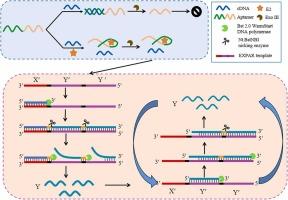基于适配体和等温指数扩增反应的 17β-estradiol 超灵敏荧光策略
IF 8
1区 化学
Q1 CHEMISTRY, ANALYTICAL
引用次数: 0
摘要
人类在养殖过程中滥用 17β-estradiol (E2),并将其排泄到环境中,导致人类接触到 E2。过量的 E2 会对人体内分泌系统造成不良影响。因此,需要一种高效、灵敏的 E2 分析方法。在此,基于对aptamer的特异性捕获和od Exonuclease III的消化、等温指数扩增反应(EXPAR)的高效扩增,建立了一种高灵敏度、高选择性的E2分析策略。E2 因其高亲和力而与适配体结合,阻止适配体的互补 DNA(cDNA)与之杂交。因此,cDNA 在溶液中保持未结合的自由状态。cDNA 作为引物,在 Bst 2.0 WarmStart DNA 聚合酶和 Nt.BstNBⅠ 核酸酶的帮助下触发 EXPAR,从而实现对 E2 的灵敏检测。在没有 E2 的情况下,cDNA 会与适配体杂交形成双链 DNA,而双链 DNA 会被 Exonuclease III 降解。因此,扩增反应无法启动。该方法的线性范围为 100 aM-10 pM,跨越 5 个数量级,检测限低至 36 aM。此外,该方法的选择性和重现性也很好,在自来水和牛奶中的回收率为 99.4% 至 117.3%,表明该方法具有良好的实用性。该方法还为利用相应的适配体高灵敏地检测其他小分子靶标提供了新的可能。本文章由计算机程序翻译,如有差异,请以英文原文为准。

An ultrasensitive fluorescent strategy for 17β-estradiol based on aptamer and isothermal exponential amplification reaction
The abuse of 17β-estradiol (E2) in breeding and the excretion into the environment by human beings result in exposure of E2 to humans. Excessive levels of E2 can cause an adverse effect on the human endocrine systems. Therefore, an efficient and sensitive method for the analysis of E2 is required. Herein, based on the specific capture of aptamer, the digestion of Exonuclease III, and efficient amplification of isothermal exponential amplification reaction (EXPAR), a highly sensitive and selective strategy is established for E2 analysis. E2 binds to the aptamer due to their high affinity, preventing the complementary DNA (cDNA) of the aptamer from hybridizing with it. Thus, the cDNA remains unbound and freely available in the solution. Then, Exonuclease III digests the cDNA-aptamer complex, leaving the free cDNA intact. cDNA serves as primers to trigger EXPAR with the help of Bst 2.0 WarmStart DNA polymerase and Nt.BstNBI nicking enzyme, achieving sensitive detection of E2. Without E2, cDNA hybridizes with the aptamer to form double-stranded DNA, which is degraded by Exonuclease III. As a result, the amplification reaction fails to initiate. The approach shows a linear range of 100 aM-10 pM, spanning 5 orders of magnitude, with the limit of detection as low as 36 aM. In addition, the selectivity and reproducibility are great, and the recoveries in tap water and milk ranges from 99.4 % to 117.3 %, suggesting good practicability. This method may also provide a new possibility for sensitive detection of other small-molecule targets via using the corresponding aptamers.
求助全文
通过发布文献求助,成功后即可免费获取论文全文。
去求助
来源期刊

Sensors and Actuators B: Chemical
工程技术-电化学
CiteScore
14.60
自引率
11.90%
发文量
1776
审稿时长
3.2 months
期刊介绍:
Sensors & Actuators, B: Chemical is an international journal focused on the research and development of chemical transducers. It covers chemical sensors and biosensors, chemical actuators, and analytical microsystems. The journal is interdisciplinary, aiming to publish original works showcasing substantial advancements beyond the current state of the art in these fields, with practical applicability to solving meaningful analytical problems. Review articles are accepted by invitation from an Editor of the journal.
 求助内容:
求助内容: 应助结果提醒方式:
应助结果提醒方式:


